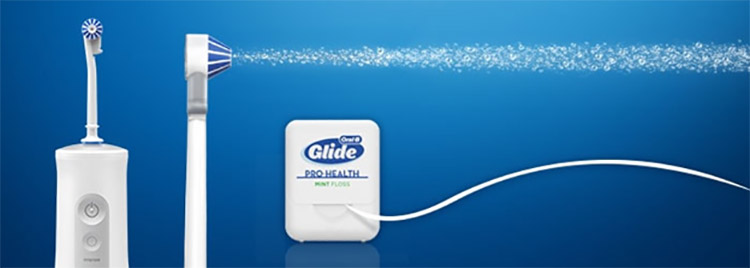Water Flossers Vs. String Floss

Table of Contents
Essential Part of an Oral Care Routine
It's recommended that you floss at least once a day in addition to brushing twice a day to maintain good oral health. Flossing removes trapped food debris, plaque and bacteria in hard-to-reach spaces between teeth and gums where your toothbrush can't reach. Without daily flossing, bacteria will calcify, turn to tartar, and lead to gum problems.
Water Flosser Vs. String Floss
Flossing involves threading a thin string of nylon or Teflon between teeth in a C-shape pattern to remove plaque. A water flosser, also known as an oral irrigator, works by shooting out a thin, pressurized stream of water between teeth. Some may find a water flosser is easier to use than traditional floss. It's much less hands on, and less technique intensive. The Oral-B Water Flosser Advanced Cordless Irrigator is designed to deep clean and detoxify* below the gum line. Its unique Oxyjet Technology targets and helps eliminate plaque bacteria for healthier gums.
When choosing between a water flosser or string floss, be sure to think about:
- Ease of Use: String floss is fairly easy to use, but very technique intensive. Many find an oral irrigator to be far more convenient and a great addition to their oral care routine.
- Electricity: Most water flossers are electric, so they'll need to be plugged into an outlet in your bathroom.
- Customization — While there are many different types of floss, they all involve weaving a thin piece of nylon between your teeth. There aren't many ways to account for issues like sensitive gums. An oral irrigator with multiple pressure settings, especially one with a sensitive mode, like the Oral-B Water Flosser, is great if gum sensitivity is a problem for you.
Which is Better?
It is not recommended to replace traditional flossing with water flossing. While water flossers do a great job of removing food particles and rinsing away plaque by shooting a stream of water between your teeth, they cannot replicate the scraping motion of string floss that removes tartar-causing plaque that can eventually cause gum disease. It's best to incorporate both traditional and water flossing to your daily routine for optimal oral hygiene.
However, there are some instances where an oral irrigator may be seen as a better option to string floss:
- Sensitive Gums — Water flossers may be a less painful option for people with sensitive gums.
- Braces — The pressurized water from a water flosser is one of the best ways to get food out of your braces without having to weave traditional dental floss in and out of your teeth.
- Dexterity issues — An oral irrigator can be particularly useful for people with arthritis or braces, where maneuvering string floss can prove difficult.
In these situations when string floss can't be used, a water flosser is great in combination with string flossing.
Be sure to follow a thorough oral care routine to ensure your gums stay healthy and teeth strong:
- Brush twice daily with an electric toothbrush like the Oral-B iO to remove 100% more plaque than a regular manual brush.
- Floss at least once a day with string floss then follow it up with the Oral-B Water Flosser to better eliminate plaque bacteria from the gum line.
- Visit your dentist or dental hygienist at least twice a year for professional cleanings and checkups.
From Oral-B, the #1 dentist-recommended toothbrush brand, worldwide.
*Helps reduce plaque bacteria and inflammatory components associated with gingivitis, when used as an adjunct to brushing, flossing and regular professional care.
Table of Contents
- Essential Part of an Oral Care Routine
- Water Flosser Vs. String Floss
- Which is Better?

Sign Up
for expert advice and exclusive offers

Sign Up
for expert advice and exclusive offers
